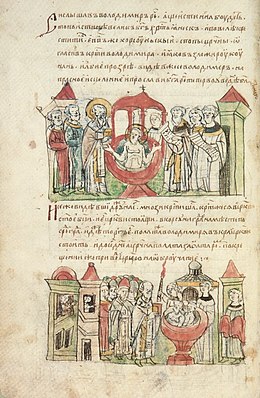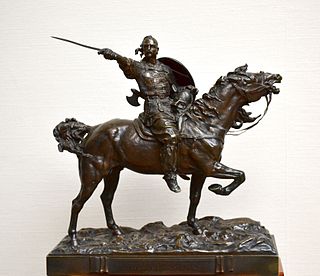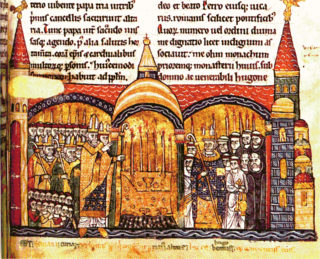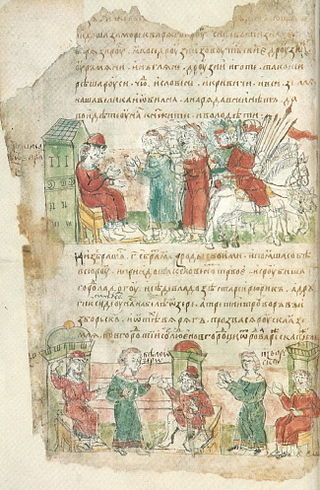According to the Primary Chronicle

The Primary Chronicle (Povest' vremennykh let, PVL), which was compiled in the 1110s, about 128 years after the events it narrates, [1] contains the story of Volodimer's conversion in pages 84–121.
Contents
The account of Volodimer's conversion [1] is a compilation of four distinct conversion stories loosely tied together (as identified by Donald Ostrowski 2006 and other scholars): [1]
- The "Examination of Religions" part 1: "the missionaries coming to Kyiv" – set in the year 6494 (986/7) [9]
- The "Examination of Religions" part 2: "Volodimer's sending envoys to various peoples" – set in the year 6495 (987/8) [9]
- The "Kherson/Korsun Legend" part 1: "the capture of Kherson resulting in negotiations for the hand of the sister of the co-emperors of Byzantium" [9] – set in the year 6496 (988/9) [10]
- The "Kherson/Korsun Legend" part 2: "the curing of Volodimer's blindness through baptism". [9]
"Missionaries coming to Kyiv"
The Primary Chronicle reports that, in the year 6495 (987), missionaries from 'the Bulgars' (representing Islam [9] ), 'the Germans' (Немци Nemtsi, representing Western Christianity [9] ), 'the Jews' (representing Judaism; these may have been Khazars [9] ), and 'the Greeks' (representing Eastern Christianity), came to Kiev to in attempts to have Volodimer convert to their particular religion. [9] Ostrowski (2006) remarked: 'The entire episode of the missionaries is reminiscent of a disputation before the Khazar Khagan Bulan in the eighth century.' [11]
The result is described in the following apocryphal anecdote. Upon the meeting with envoys of the Volga Bulgars, Volodimer found their religion unsuitable due to its requirement to circumcise and taboos against wine and pork; supposedly, Volodimer said on that occasion: "Drinking is the joy of the Rus'." [12] [ non-primary source needed ] He also consulted with Jewish envoys (who may or may not have been Khazars), questioned them about Judaism but ultimately rejected it, saying that their loss of Jerusalem was evidence of their having been abandoned by God. [12] [ non-primary source needed ] However, the long speech of a Greek philosopher (known as the "Philosopher's Speech" [9] ), providing an exegesis of the Old and New Testaments in favour of Eastern Christianity, impresses Volodimer. [9] Nevertheless, he hesitates and does not convert. [9]
"Volodimer's sending envoys to various peoples"
In the year 987, as the result of a consultation with his boyars, Volodimer sent envoys to study the religions of three neighbouring peoples – the Islamic Volga Bolgars, the Western Christian Germans, and the Eastern Christian Greeks, whose representatives had been urging him to embrace their respective faiths. It is unclear why no delegation was sent to the Jewish Khazars, who are also mentioned in story 1. [13]
Of the Muslim Bulgarians of the Volga the envoys reported there is no joy among them; only sorrow and a great stench. In the gloomy churches of the Germans his emissaries saw no beauty; but at Hagia Sophia, where the full festival ritual of the Byzantine Church was set in motion to impress them, they found their ideal: "We did not know whether we were in heaven or on earth", they reported. [10]
Presented with these reports, once again clearly in favour of Greek Eastern Christianity, Volodimer again hesitates, and does not convert. [10]
"Capture of Kherson, Byzantine princess marriage negotiations"
In the Primary Chronicle, the account of Volodimer's baptism is preceded by the so-called Korsun Legend. According to this apocryphal story, in 988 Volodimer besieges the Greek town of Kherson (Chersonesus, Korsun'). He tries to cut the city's water-supply, and vows to convert Christianity if the plan works: "If this is successful, I will be baptised" (Church Slavonic : Аще се ся събудеть, имамь ся крьстити). [10] However, Volodimer does not convert upon capturing the town, and the vow is never mentioned again. [10]
After capturing Kherson, Volodimer sends a message threatening the co-emperors Basil and Constantine to attack and occupy Constantinople itself unless he is promised the hand of their sister, Anna Porphyrogenita, in marriage. [10] The three monarchs then conduct negotiations, during which the emperors demand Volodimer be baptised before marrying off their sister to him, and Volodimer promises that he will be baptised by the priests in Anna's company once she arrives. [10] Anna vehemently protests the whole arrangement: 'It is as if I were setting out into captivity,' she lamented; 'better were it for me to die at home'. [14] [ non-primary source needed ] Her co-Emperor brothers beg her to go: 'Through your agency God turns the land of Rus' to repentance, and you will relieve Greece from the danger of grievous war. Do you not see how much harm the Rus' have already brought upon the Greeks? If you do not set out, they may bring on us the same misfortunes.' [15] [ non-primary source needed ] Thus, for the sake of peace between Byzantium and Kiev, she agrees. [16] [ non-primary source needed ] A tearful princess Anna says goodbye to her homeland, and arrives at Kherson, where the town's inhabitants receive her. [16] [ non-primary source needed ]
"Curing of Volodimer's blindness through baptism"
Prior to the wedding, just when Anna arrives, Volodimer is suddenly struck by blindness. [10] Anna tells him to get baptised so that he will regain his sight. [10] And so he is baptised, instantly being cured from blindness. [10] The Chronicle states that the baptism happened in Chersonesus, although the text says some people have mistakenly claimed it happened in Kiev, Vasil'ev, or elsewhere instead. [1] The sacrament was followed by his marriage with the Byzantine princess. [17] [ non-primary source needed ]
Literary analysis
'Those who do not know the truth say he was baptized in Kyiv, while others said he was baptized in Vasil'ev, with still others saying elsewhere.'
– Sylvester, Primary Chronicle (1110s) [1]
Shepard (1992) observed that each story works up to a punchline, namely the ruler's conversion, but each time Volodimer hesitates and postpones the decision, whereupon the next story immediately begins. [9] Ostrowski (2006) argued that 'the view that the account appearing in the PVL is mostly a literary invention should now be accepted.' [1] He argued that the narrative was a compilation of four distinct stories involving five separate traditions that were woven into a single account, but the traces of the originally separate stories can still be found, including internal contradictions. [1] The compiler, probably Sylvester of Kiev, noted that there was disagreement about where Volodimer was baptised, himself insisting that it happened at Kherson by saying: 'Those who do not know the truth say he was baptized in Kyiv, while others said he was baptized in Vasil'ev, with still others saying elsewhere.' [1] This shows that Syvester had access to multiple inconsistent accounts, had to choose which one to believe, copyedit, and write down, and to exclude all those souces which said something else about where the baptism happened (at least three competing alternative locations in total). [1] Four of the five traditions contained elements which 'are similar to, and borrow from, traditions told about the conversion of previous rulers in other countries, and thus can be considered literary commonplaces.' [1]
Although 'Jews' are mentioned in "Examination of Religions" part 1, Volodimer does not send any envoys to the Khazars in part 2; Ostrowski suggested 'probably it was because no independent Khazar kingdom existed at that time.' [10] Ostrowski found Volodimer's vow to convert upon the capture of Kherson to be 'gratuitous', and 'completely out of context' if it weren't for Volodimer's already implicit sympathy for Byzantine Christianity due to the two earlier "Examination of Religions" stories, judging that this one sentence containing a pre-conquest vow 'more likely represents a different tradition'. [10] The vow does not make sense in the story: Volodimer does not make this promise to anyone who asks him (unlike the two previous occasions), and after he captures Kherson, Volodimer does not follow through and convert; the vow isn't even mentioned again after the battle. [10]
About the last part, Ostrowski observed: 'From a narrative point of view, story 4 appears unnecessary, since Volodimer has already promised to be baptized as soon as Anna arrives with priests.' [10]
Stylistic analysis
Donald Ostrowski (2006) identified two chiastic structures within the Primary Chronicle (PVL) account of Volodimer's conversion.
A: 'Foreign missionaries come to Volodimer in Kyiv to tell about their respective religions' [18]
A': 'Volodimer sends envoys out to report on the religions of the people they visit' [18] |
A: 'Volodimer vows to be baptized if he is successful in capturing Kherson' [20]
A': 'Volodimer is baptized on Anna's instruction and regains his sight' [21] |
Historical analyis
'It is an obvious anachronism to represent Byzantine Christianity before 1054 as a different religion (as different as Judaism or Islam) from Catholic Christianity.'
– Samuel Hazzard Cross (1930) [22]
Andrzej Poppe (1988) dated the "Examination of Religions" narrative to 'not earlier than the second half of the eleventh century', and the "Kherson Legend" to the 1070s–1080s. [9] These traditions were compiled in the 1110s into the Primary Chronicle (PVL) account of Volodimer's conversion, about 128 years after the purported events. [1] It gives insights about what the Chronicle's compilers thought had happened. [1] Johnsson Hraundal added that 'the text [of the Primary Chronicle] was compiled much later than the period in question, in a rather different context, and is first and foremost a literary expression of the civilization and political system prevailing in Kiev at the time of its composition.' [23]
Cross (1930) mentioned that 'the presentation of this story in which Western Christianity represented as a religion that is as different from Eastern Christianity as Islam and Judaism presupposes that the final split between Rome and Constantinople, which usually is dated to 1054, had already occurred.' [24] Jonsson Hraundal stated that one of the PVL's goals was 'to write the Rus lands and its people into Christian universal history', and that the adoption of Christianity was one of the narratives which could be corroborated due to being attested in Byzantine sources. [25] However, Ostrowski remarked that regarding Volodimer's conversion 'only one of the [five] traditions – negotiations for the hand of Anna – finds independent corroboration in other sources of the time.' [9]
Traditional Russian, Ukrainian and Belarusian historiography had assumed Volodimer was solely motivated to conquer Chersonesus in order to force the Byzantine emperors to marry off their sister to him. [9] According to Poppe, the siege and capture of Chersonesus by the military of Kievan Rus' had to be connected with the concurrent rebellion of Bardas Phokas the Younger (February 987 – October 989), in which Chersonesus fell to rebel hands, while Volodimer allied with the forces loyal to the Byzantine emperors and (re)captured it on their behalf. [9] The marriage arrangement, the promise to convert to (Byzantine) Christianity, and the siege of Chersonesus, were thus all part of that alliance between Volodimer and Basil & Constantine against the rebel forces of Phokas. [9]















